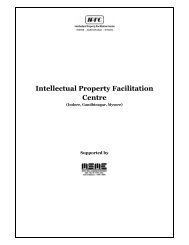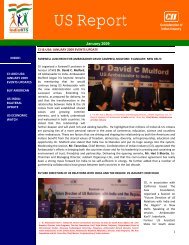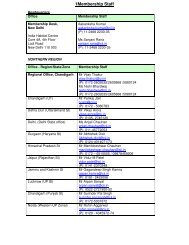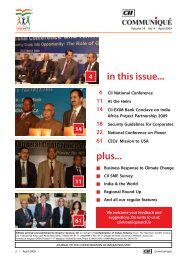policy pulsepolicy pulsePhysical InfrastructureThe relationship between infrastructure development and economic growth is well established. Superior infrastructure reducescost of doing business and enhances the investment attractiveness of the State/region. The development experience of theIndian States, bears out the fact that States with better infrastructure facilities have witnessed rapid industrialization. For them,infrastructure development remains central to the economic objective of achieving higher growth rates.Infrastructure bottlenecks not only slow down growth but also increase the cost of doing of business thereby adversely impactingindustrial competitiveness. For example inIndia, logistics cost is around 13 per centInfrastructure in the Northern Regionof GDP, which is high compared to 9-10Northern Region (NR) All Indiaper cent in the developed economies 1 . Power Installed Capacity (in MW) 42,189 1,59,399Northern Region, encompassing theHydro – 31.6 Hydro – 23.1UT of Chandigarh, and States of Delhi,Thermal – 58.9 Thermal – 64.3Haryana, Himachal Pradesh, Jammu & Energy mix (in %)Nuclear – 3.8 Nuclear – 2.9Kashmir, Punjab, Rajasthan, Uttar Pradesh &Renewable Energy Renewable EnergyUttarakhand, is one of the largest regions inSources –5.7 Sources – 9.7the country. In addition to the geographicalexpanse, the region also has huge varietyof terrain, is landlocked creating addedlogistical challenges for the industry. GoodInfrastructure therefore becomes evenmore essential for the economic and socialprogress of the region.A look at summary indicators showsthat overall the Northern Region haskept pace with the infrastructuredevelopment across the country.National Highway Length (km) 20,220 70,934Length of NH in km/ 1000 sq km 20.0 21.6Total Rail Network (km) 19,311 64,015Length of Rail line in km/ 1000 sq km 19.1 19.5International Airports (No.) 4 14Domestic Airports (No.) 27 103Telephone Subscribers (Million) 192 621No. of Telephones/ 100 population 52.7 52.7Source: Central Electricity Authority (CEA), Ministry of Road Transport & Highways, Ministry of Railways, Ministryof Civil Aviation, Telecom Regulatory Authority of India (TRAI)However there are significantvariations across the region.Power: The total installed capacity inNorthern Region as of March, 2010, is42,189 MW. Of the current generationcapacity, the share of thermal hasremained the highest at about 58.9 percent. The share of renewable energy hasgone up from 1.19 per cent at the end of1KPMG – <strong>CII</strong> Report on “Competitiveness Through Efficient Logistics”March 2005 to 5.7 per cent presently, butstill continues to be much lower than the allIndia percentage. The share of hydro hasdeclined from 33.15 per cent at the endof March 2005 to 31.6 per cent at the endof March 2010 while that for nuclear hasremained more or less constant at 3.80per cent as compared to 3.63 at the endof March 2005.Despite having a share of 26.5 percent in the overall installed generationcapacity in India, the peak demandsupplydeficit is higher in northern regionat 15.4 per cent compared to all India(13.3 per cent).Within the region, Punjab, Uttar Pradeshand Jammu & Kashmir have the highestpower deficits of 24.3, 21.1 and 32.3 percent respectively. Uttarakhand (6.0 per cent)10 C I I n o r t h e r n r e g i o n n e w s l e t t e r
policy pulseand Haryana (7.4 per cent) also fall under the category of powerdeficit states but the deficit is much lower compared to Punjab, UttarPradesh and Jammu & Kashmir. The deficit situation in Haryana,Rajasthan, Uttarakhand, Delhi and Chandigarh is better comparedto the all India average. Himachal is the only power surplus Statein the region.70.5 per cent of the region’s power generation capacity isconcentrated in the States of Uttar Pradesh, Rajasthan, Punjaband Haryana.In terms of energy consumed by different sectors, it is observedthat there is high demand for energy from the industrial sector ofthe region, particularly in HP, Uttarakhand, Punjab and Haryanawhere industrial activity is booming. In the two lead agrarianStates of the region, Punjab & Haryana demand for energy foragricultural purposes is significant.The annual plan outlays of Northern States (for the year 2009-10) have given great importance to power sector. Rajasthanand Punjab have allocated 43.2 and 30.2 per cent of the totaloutlay to power sector alone. Uttar Pradesh has sanctionedaround Rs 60 billion to this sector. While the States like Jammu& Kashmir, Uttarakhand and Himachal Pradesh have allocatedlower amount (as a percentage of total plan outlay) for thepower sector.Roads: Northern region due to its expanse has low density ofsurface transport infrastructure facilities. In terms of density ofroad the region lags behind national average.The total length of national highways in the region is 20,220 kms.Rajasthan (5,722) followed by Uttar Pradesh (5,670), Punjab(1,739) and Himachal Pradesh (1,471) have the largest networkof National Highways (NH) in NR. Additionally, many of the statehighways have also been declared as national highways due tothe rising traffic on these stretches. The existing road networkis being upgraded and express highways and freeways beingconstructed along the key routes in Delhi and the NCR. The “GoldenQuadrilateral” project of the National Highways Authority of India(NHAI) directly connects Delhi to other major cities of the country.In case of states like Punjab (with total road network of 54,883km) and Rajasthan (with total road network of 1,85,043 kms)there has been good participation of private sector in the roadsector of the States on account of a strong policy and institutionalframework for PPP projects.Even Uttar Pradesh (with road network of 1,39,362 km) hastaken definite steps to improve its road network by launchingsome of the biggest projects in the country on a PPP basis likethe Yamuna Expressway and Ganga Expressway.Since Himachal Pradesh is a hilly State, roads play a vital rolein transportation. Of the total road length of 27,260 km, NHaccounts for 1,471 km.Also, the Public-Private Partnership (PPP) projects are playingan important role in the development of transportation sectorof the northern region. The NR States have been witnessing asignificant growth in number of projects in transport infrastructure.States with estimated costs of PPP projects worth more than Rs 1billion in the transport infrastructure development include Delhi,Haryana, Uttar Pradesh and Rajasthan. Among other States ofthe region, Jammu & Kashmir and Punjab also have significantPPP projects in the transport sector whereas Himachal Pradeshand Uttarakhand lag behind.Railways: The Northern Region has a total rail network of19,311 km. Punjab, Haryana and Uttar Pradesh have wellspread rail connectivity. Haryana has a railway-route lengthof roughly 1,595 kms. Punjab’s railway network spans over2,133 kms. Rajasthan has a total railway network spanning5,854 kms. However it is Uttar Pradesh’s rail network whichis the largest in the region as well as in the country. The Stateis well-connected to other parts of the country by a railwaynetwork spanning over 8,703 km.Airports: Out of total of 14 international airports in the country,the region has four international airports (Amritsar, Jaipur,Srinagar, and Delhi). Correspondingly 27 out of a total of 103domestic airports are located in the northern region. The regionaccounts for 22.7 per cent of the nation’s aircraft movement.Haryana, Punjab and UT of Chandigarh share airport atChandigarh, which is now being upgraded to an internationalairport. The project is jointly being undertaken by theGovernments of Punjab and Haryana.Telecommunication: Telecommunication plays a crucial rolein making the fruits of economic growth and developmentmore inclusive. In terms of total subscriber base (includingboth wire-line and wire-less), the share of NR is about 31 percent. However the region has a lower tele-density comparedto all India as measured by number of telephone connectionsper hundred populations.Delhi circle has the highest Teledensity (172) in the regionfollowed by Himachal Pradesh (79). Uttarakhand has thelowest teledensity, much lower than the other hill States in theregion – Jammu & Kashmir and Himachal. Uttar Pradesh hasthe largest subscriber base but a relatively low Teledensity.(This is an abridged version of the report titled, “Physical Infrastructure: AComparative Study of Northern States”. Requests for the complete documentcould be sent at erpd@cii.in)— ¤ —f e b r u a r y 2 0 1 111
















